2003 NISSAN 350Z trip computer
[x] Cancel search: trip computerPage 120 of 227
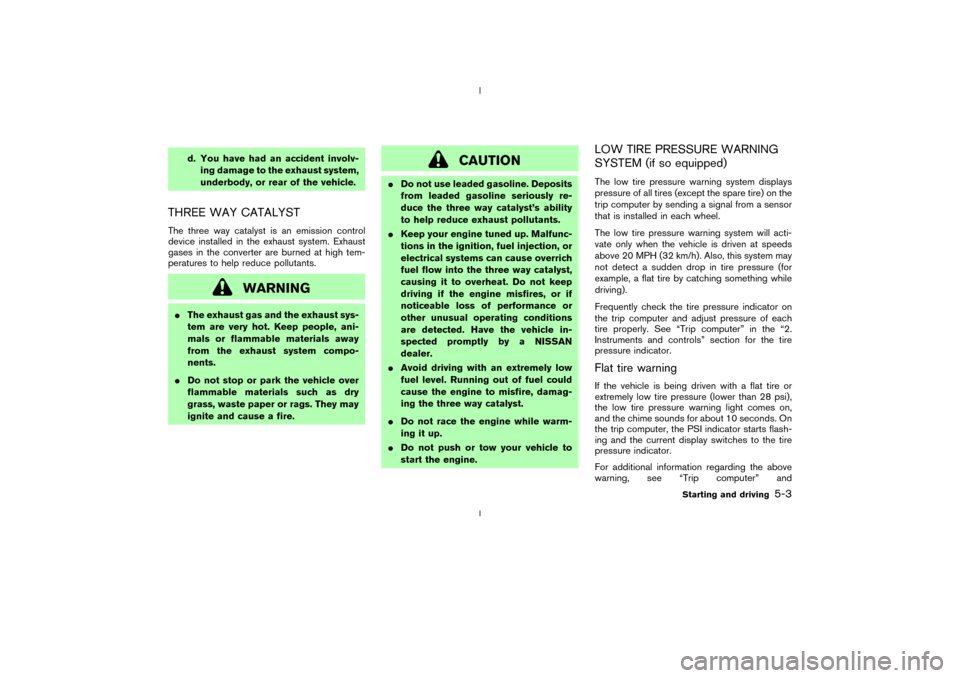
d. You have had an accident involv-
ing damage to the exhaust system,
underbody, or rear of the vehicle.
THREE WAY CATALYSTThe three way catalyst is an emission control
device installed in the exhaust system. Exhaust
gases in the converter are burned at high tem-
peratures to help reduce pollutants.
WARNING
IThe exhaust gas and the exhaust sys-
tem are very hot. Keep people, ani-
mals or flammable materials away
from the exhaust system compo-
nents.
IDo not stop or park the vehicle over
flammable materials such as dry
grass, waste paper or rags. They may
ignite and cause a fire.
CAUTION
IDo not use leaded gasoline. Deposits
from leaded gasoline seriously re-
duce the three way catalyst's ability
to help reduce exhaust pollutants.
IKeep your engine tuned up. Malfunc-
tions in the ignition, fuel injection, or
electrical systems can cause overrich
fuel flow into the three way catalyst,
causing it to overheat. Do not keep
driving if the engine misfires, or if
noticeable loss of performance or
other unusual operating conditions
are detected. Have the vehicle in-
spected promptly by a NISSAN
dealer.
IAvoid driving with an extremely low
fuel level. Running out of fuel could
cause the engine to misfire, damag-
ing the three way catalyst.
IDo not race the engine while warm-
ing it up.
IDo not push or tow your vehicle to
start the engine.
LOW TIRE PRESSURE WARNING
SYSTEM (if so equipped)The low tire pressure warning system displays
pressure of all tires (except the spare tire) on the
trip computer by sending a signal from a sensor
that is installed in each wheel.
The low tire pressure warning system will acti-
vate only when the vehicle is driven at speeds
above 20 MPH (32 km/h). Also, this system may
not detect a sudden drop in tire pressure (for
example, a flat tire by catching something while
driving).
Frequently check the tire pressure indicator on
the trip computer and adjust pressure of each
tire properly. See ªTrip computerº in the ª2.
Instruments and controlsº section for the tire
pressure indicator.Flat tire warningIf the vehicle is being driven with a flat tire or
extremely low tire pressure (lower than 28 psi),
the low tire pressure warning light comes on,
and the chime sounds for about 10 seconds. On
the trip computer, the PSI indicator starts flash-
ing and the current display switches to the tire
pressure indicator.
For additional information regarding the above
warning, see ªTrip computerº and
Starting and driving
5-3
Z
02.9.13/Z33-D/V5.0
X
Page 121 of 227
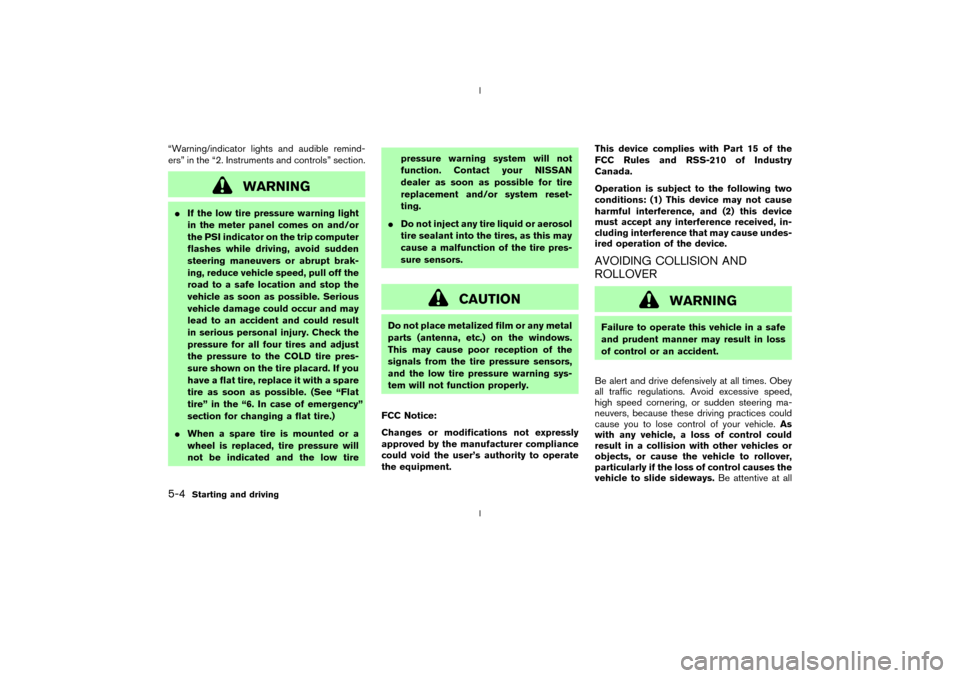
ªWarning/indicator lights and audible remind-
ersº in the ª2. Instruments and controlsº section.
WARNING
IIf the low tire pressure warning light
in the meter panel comes on and/or
the PSI indicator on the trip computer
flashes while driving, avoid sudden
steering maneuvers or abrupt brak-
ing, reduce vehicle speed, pull off the
road to a safe location and stop the
vehicle as soon as possible. Serious
vehicle damage could occur and may
lead to an accident and could result
in serious personal injury. Check the
pressure for all four tires and adjust
the pressure to the COLD tire pres-
sure shown on the tire placard. If you
have a flat tire, replace it with a spare
tire as soon as possible. (See ªFlat
tireº in the ª6. In case of emergencyº
section for changing a flat tire.)
IWhen a spare tire is mounted or a
wheel is replaced, tire pressure will
not be indicated and the low tirepressure warning system will not
function. Contact your NISSAN
dealer as soon as possible for tire
replacement and/or system reset-
ting.
IDo not inject any tire liquid or aerosol
tire sealant into the tires, as this may
cause a malfunction of the tire pres-
sure sensors.
CAUTION
Do not place metalized film or any metal
parts (antenna, etc.) on the windows.
This may cause poor reception of the
signals from the tire pressure sensors,
and the low tire pressure warning sys-
tem will not function properly.
FCC Notice:
Changes or modifications not expressly
approved by the manufacturer compliance
could void the user's authority to operate
the equipment.This device complies with Part 15 of the
FCC Rules and RSS-210 of Industry
Canada.
Operation is subject to the following two
conditions: (1) This device may not cause
harmful interference, and (2) this device
must accept any interference received, in-
cluding interference that may cause undes-
ired operation of the device.
AVOIDING COLLISION AND
ROLLOVER
WARNING
Failure to operate this vehicle in a safe
and prudent manner may result in loss
of control or an accident.
Be alert and drive defensively at all times. Obey
all traffic regulations. Avoid excessive speed,
high speed cornering, or sudden steering ma-
neuvers, because these driving practices could
cause you to lose control of your vehicle.As
with any vehicle, a loss of control could
result in a collision with other vehicles or
objects, or cause the vehicle to rollover,
particularly if the loss of control causes the
vehicle to slide sideways.Be attentive at all
5-4
Starting and driving
Z
02.9.13/Z33-D/V5.0
X
Page 130 of 227
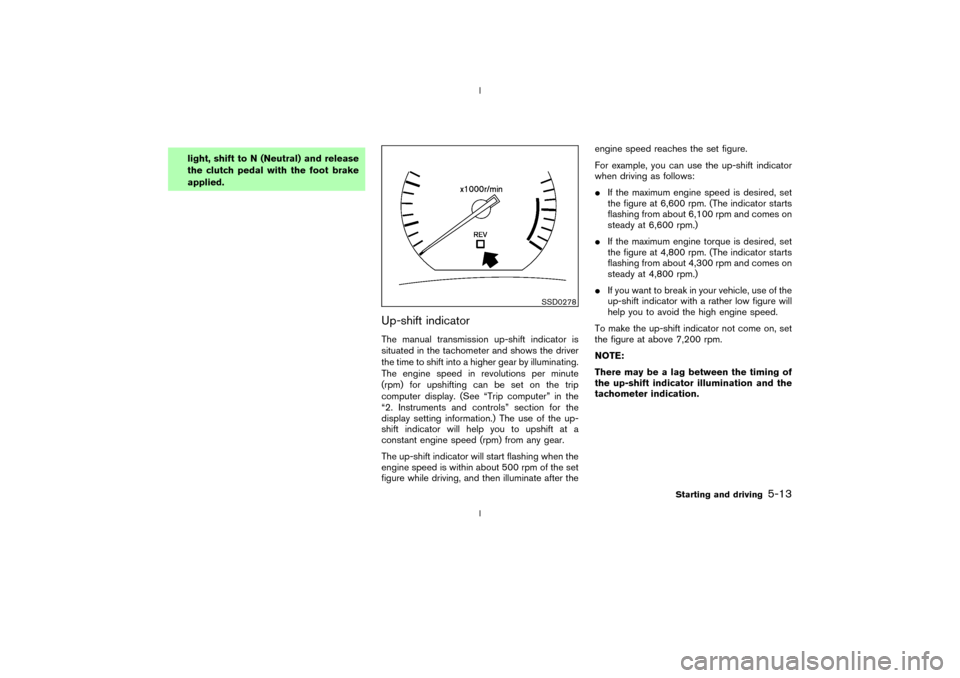
light, shift to N (Neutral) and release
the clutch pedal with the foot brake
applied.
Up-shift indicatorThe manual transmission up-shift indicator is
situated in the tachometer and shows the driver
the time to shift into a higher gear by illuminating.
The engine speed in revolutions per minute
(rpm) for upshifting can be set on the trip
computer display. (See ªTrip computerº in the
ª2. Instruments and controlsº section for the
display setting information.) The use of the up-
shift indicator will help you to upshift at a
constant engine speed (rpm) from any gear.
The up-shift indicator will start flashing when the
engine speed is within about 500 rpm of the set
figure while driving, and then illuminate after theengine speed reaches the set figure.
For example, you can use the up-shift indicator
when driving as follows:
IIf the maximum engine speed is desired, set
the figure at 6,600 rpm. (The indicator starts
flashing from about 6,100 rpm and comes on
steady at 6,600 rpm.)
IIf the maximum engine torque is desired, set
the figure at 4,800 rpm. (The indicator starts
flashing from about 4,300 rpm and comes on
steady at 4,800 rpm.)
IIf you want to break in your vehicle, use of the
up-shift indicator with a rather low figure will
help you to avoid the high engine speed.
To make the up-shift indicator not come on, set
the figure at above 7,200 rpm.
NOTE:
There may be a lag between the timing of
the up-shift indicator illumination and the
tachometer indication.
SSD0278
Starting and driving
5-13
Z
02.9.13/Z33-D/V5.0
X
Page 145 of 227
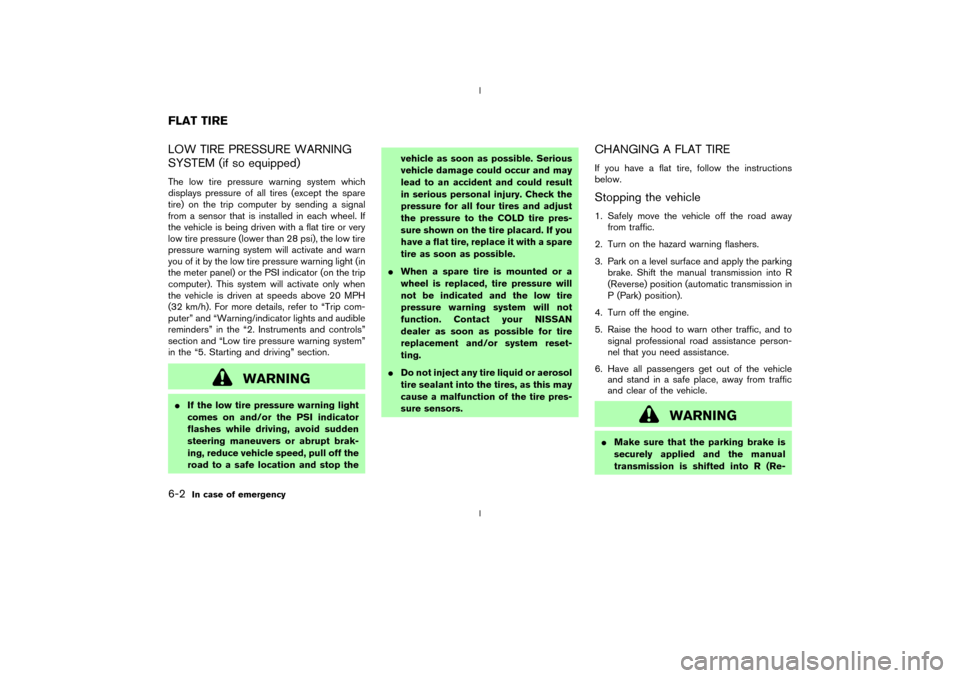
LOW TIRE PRESSURE WARNING
SYSTEM (if so equipped)The low tire pressure warning system which
displays pressure of all tires (except the spare
tire) on the trip computer by sending a signal
from a sensor that is installed in each wheel. If
the vehicle is being driven with a flat tire or very
low tire pressure (lower than 28 psi), the low tire
pressure warning system will activate and warn
you of it by the low tire pressure warning light (in
the meter panel) or the PSI indicator (on the trip
computer). This system will activate only when
the vehicle is driven at speeds above 20 MPH
(32 km/h). For more details, refer to ªTrip com-
puterº and ªWarning/indicator lights and audible
remindersº in the ª2. Instruments and controlsº
section and ªLow tire pressure warning systemº
in the ª5. Starting and drivingº section.
WARNING
IIf the low tire pressure warning light
comes on and/or the PSI indicator
flashes while driving, avoid sudden
steering maneuvers or abrupt brak-
ing, reduce vehicle speed, pull off the
road to a safe location and stop thevehicle as soon as possible. Serious
vehicle damage could occur and may
lead to an accident and could result
in serious personal injury. Check the
pressure for all four tires and adjust
the pressure to the COLD tire pres-
sure shown on the tire placard. If you
have a flat tire, replace it with a spare
tire as soon as possible.
IWhen a spare tire is mounted or a
wheel is replaced, tire pressure will
not be indicated and the low tire
pressure warning system will not
function. Contact your NISSAN
dealer as soon as possible for tire
replacement and/or system reset-
ting.
IDo not inject any tire liquid or aerosol
tire sealant into the tires, as this may
cause a malfunction of the tire pres-
sure sensors.
CHANGING A FLAT TIREIf you have a flat tire, follow the instructions
below.Stopping the vehicle1. Safely move the vehicle off the road away
from traffic.
2. Turn on the hazard warning flashers.
3. Park on a level surface and apply the parking
brake. Shift the manual transmission into R
(Reverse) position (automatic transmission in
P (Park) position).
4. Turn off the engine.
5. Raise the hood to warn other traffic, and to
signal professional road assistance person-
nel that you need assistance.
6. Have all passengers get out of the vehicle
and stand in a safe place, away from traffic
and clear of the vehicle.
WARNING
IMake sure that the parking brake is
securely applied and the manual
transmission is shifted into R (Re-
FLAT TIRE6-2
In case of emergency
Z
02.9.13/Z33-D/V5.0
X
Page 191 of 227
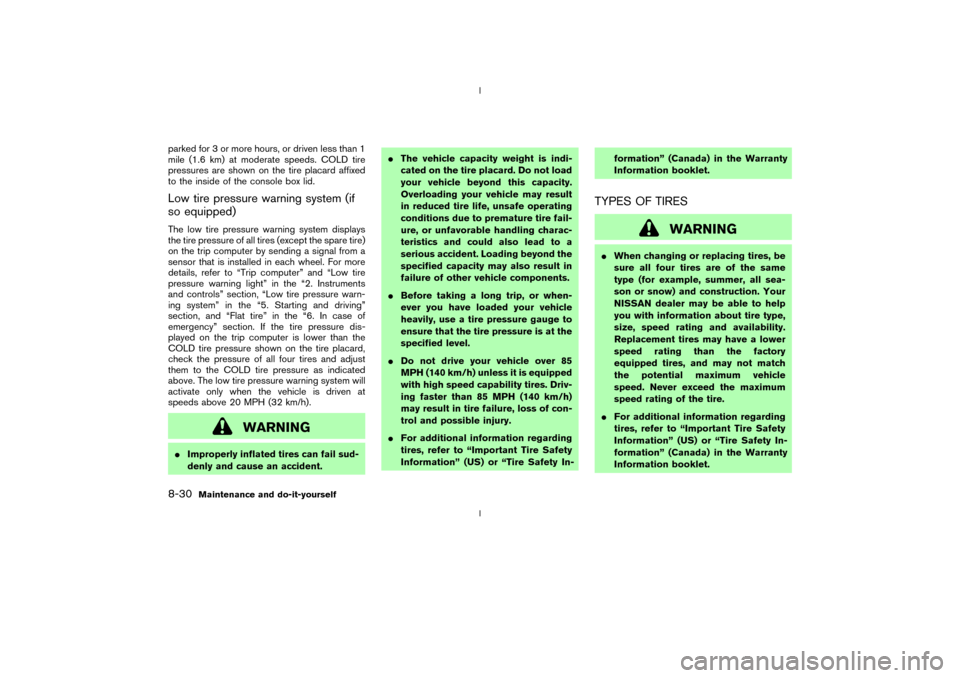
parked for 3 or more hours, or driven less than 1
mile (1.6 km) at moderate speeds. COLD tire
pressures are shown on the tire placard affixed
to the inside of the console box lid.Low tire pressure warning system (if
so equipped)The low tire pressure warning system displays
the tire pressure of all tires (except the spare tire)
on the trip computer by sending a signal from a
sensor that is installed in each wheel. For more
details, refer to ªTrip computerº and ªLow tire
pressure warning lightº in the ª2. Instruments
and controlsº section, ªLow tire pressure warn-
ing systemº in the ª5. Starting and drivingº
section, and ªFlat tireº in the ª6. In case of
emergencyº section. If the tire pressure dis-
played on the trip computer is lower than the
COLD tire pressure shown on the tire placard,
check the pressure of all four tires and adjust
them to the COLD tire pressure as indicated
above. The low tire pressure warning system will
activate only when the vehicle is driven at
speeds above 20 MPH (32 km/h).
WARNING
IImproperly inflated tires can fail sud-
denly and cause an accident.IThe vehicle capacity weight is indi-
cated on the tire placard. Do not load
your vehicle beyond this capacity.
Overloading your vehicle may result
in reduced tire life, unsafe operating
conditions due to premature tire fail-
ure, or unfavorable handling charac-
teristics and could also lead to a
serious accident. Loading beyond the
specified capacity may also result in
failure of other vehicle components.
IBefore taking a long trip, or when-
ever you have loaded your vehicle
heavily, use a tire pressure gauge to
ensure that the tire pressure is at the
specified level.
IDo not drive your vehicle over 85
MPH (140 km/h) unless it is equipped
with high speed capability tires. Driv-
ing faster than 85 MPH (140 km/h)
may result in tire failure, loss of con-
trol and possible injury.
IFor additional information regarding
tires, refer to ªImportant Tire Safety
Informationº (US) or ªTire Safety In-formationº (Canada) in the Warranty
Information booklet.
TYPES OF TIRES
WARNING
IWhen changing or replacing tires, be
sure all four tires are of the same
type (for example, summer, all sea-
son or snow) and construction. Your
NISSAN dealer may be able to help
you with information about tire type,
size, speed rating and availability.
Replacement tires may have a lower
speed rating than the factory
equipped tires, and may not match
the potential maximum vehicle
speed. Never exceed the maximum
speed rating of the tire.
IFor additional information regarding
tires, refer to ªImportant Tire Safety
Informationº (US) or ªTire Safety In-
formationº (Canada) in the Warranty
Information booklet.
8-30
Maintenance and do-it-yourself
Z
02.9.13/Z33-D/V5.0
X
Page 222 of 227
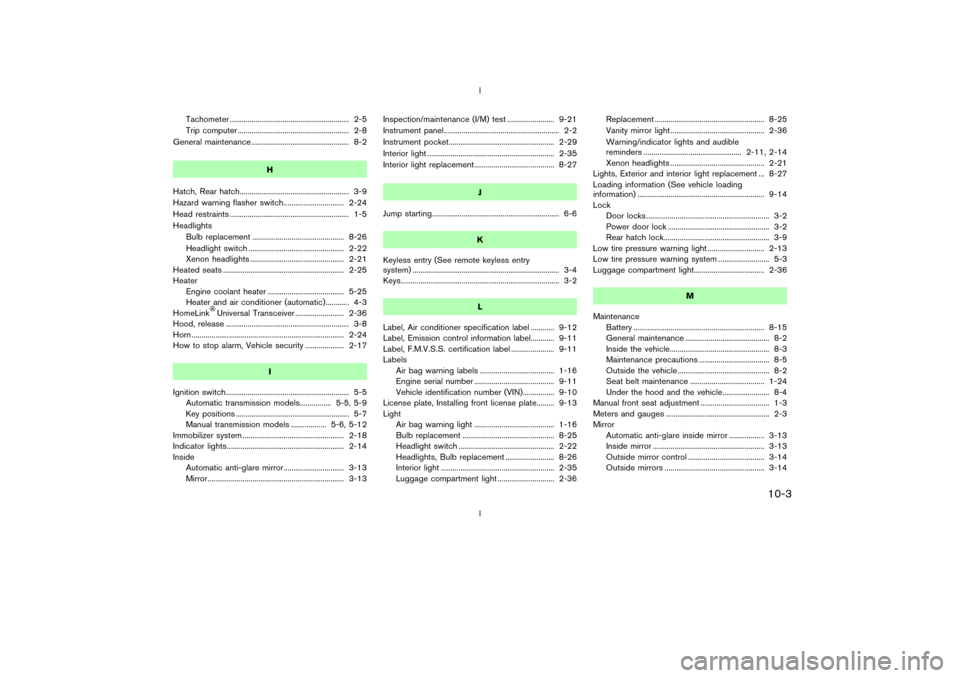
Tachometer ............................................................. 2-5
Trip computer ......................................................... 2-8
General maintenance .................................................. 8-2
H
Hatch, Rear hatch........................................................ 3-9
Hazard warning flasher switch............................... 2-24
Head restraints ............................................................. 1-5
Headlights
Bulb replacement ............................................... 8-26
Headlight switch ................................................. 2-22
Xenon headlights ................................................ 2-21
Heated seats .............................................................. 2-25
Heater
Engine coolant heater ....................................... 5-25
Heater and air conditioner (automatic)............ 4-3
HomeLink
Universal Transceiver ......................... 2-36
Hood, release ............................................................... 3-8
Horn .............................................................................. 2-24
How to stop alarm, Vehicle security .................... 2-17
I
Ignition switch ............................................................... 5-5
Automatic transmission models................ 5-5, 5-9
Key positions .......................................................... 5-7
Manual transmission models .................. 5-6, 5-12
Immobilizer system .................................................... 2-18
Indicator lights............................................................ 2-14
Inside
Automatic anti-glare mirror............................... 3-13
Mirror...................................................................... 3-13Inspection/maintenance (I/M) test ........................ 9-21
Instrument panel........................................................... 2-2
Instrument pocket...................................................... 2-29
Interior light ................................................................. 2-35
Interior light replacement......................................... 8-27
J
Jump starting................................................................. 6-6
K
Keyless entry (See remote keyless entry
system) ........................................................................... 3-4
Keys................................................................................. 3-2
L
Label, Air conditioner specification label ............ 9-12
Label, Emission control information label............ 9-11
Label, F.M.V.S.S. certification label ...................... 9-11
Labels
Air bag warning labels ...................................... 1-16
Engine serial number ......................................... 9-11
Vehicle identification number (VIN)................ 9-10
License plate, Installing front license plate......... 9-13
Light
Air bag warning light ......................................... 1-16
Bulb replacement ............................................... 8-25
Headlight switch ................................................. 2-22
Headlights, Bulb replacement ......................... 8-26
Interior light .......................................................... 2-35
Luggage compartment light ............................. 2-36Replacement ........................................................ 8-25
Vanity mirror light ................................................ 2-36
Warning/indicator lights and audible
reminders .................................................. 2-11, 2-14
Xenon headlights ................................................ 2-21
Lights, Exterior and interior light replacement ... 8-27
Loading information (See vehicle loading
information) ................................................................. 9-14
Lock
Door locks ............................................................... 3-2
Power door lock .................................................... 3-2
Rear hatch lock...................................................... 3-9
Low tire pressure warning light ............................. 2-13
Low tire pressure warning system .......................... 5-3
Luggage compartment light.................................... 2-36
M
Maintenance
Battery ................................................................... 8-15
General maintenance ........................................... 8-2
Inside the vehicle................................................... 8-3
Maintenance precautions .................................... 8-5
Outside the vehicle............................................... 8-2
Seat belt maintenance ...................................... 1-24
Under the hood and the vehicle........................ 8-4
Manual front seat adjustment ................................... 1-3
Meters and gauges ..................................................... 2-3
Mirror
Automatic anti-glare inside mirror .................. 3-13
Inside mirror ......................................................... 3-13
Outside mirror control ....................................... 3-14
Outside mirrors ................................................... 3-14
Z
02.9.13/Z33-D/V5.0
X
10-3
Page 224 of 227

Security systems (Nissan Vehicle Immobilizer
System), Engine start ............................................... 2-18
Security systems (See vehicle security
system) ......................................................................... 2-16
Servicing air conditioner ................................... 4-3, 4-6
Shift lock release ....................................................... 5-12
Shifting
Automatic transmission .............................. 5-5, 5-9
Manual transmission ................................. 5-6, 5-12
Side air bag system (See supplemental side air bag
and curtain side-impact air bag system)............. 1-13
Spark plugs................................................................. 8-17
Speedometer ................................................................ 2-4
Starting
Before starting the engine .................................. 5-8
Jump starting .......................................................... 6-6
Precautions when starting and driving ............ 5-2
Push starting .......................................................... 6-8
Starting the engine ............................................... 5-8
Steering
Power steering fluid ........................................... 8-13
Power steering system ...................................... 5-19
Tilting steering wheel......................................... 3-12
Storage ........................................................................ 2-29
Sunglasses holder .................................................... 2-29
Supplemental air bag warning labels................... 1-16
Supplemental air bag warning light .......... 1-16, 2-14
Supplemental front air bag system....................... 1-11
Supplemental side and curtain side-impact air bag
system ......................................................................... 1-13
Supplemental restraint system ................................. 1-6
Precautions on supplemental restraint
system ...................................................................... 1-6Switch
Hazard warning flasher switch ........................ 2-24
Headlight switch ................................................. 2-22
Ignition switch ........................................................ 5-5
Ignition switch automatic transmission
models ............................................................ 5-5, 5-9
Ignition switch manual transmission
models .......................................................... 5-6, 5-12
Obtaining an air bag ON/OFF switch........... 1-21
Power door lock switch....................................... 3-4
Rear window and outside mirror defroster
switch..................................................................... 2-21
Turn signal switch .............................................. 2-23
T
Tachometer.................................................................... 2-5
Temperature gauge, Engine coolant temperature
gauge .............................................................................. 2-5
Theft (Nissan Vehicle Immobilizer System), Engine
start ............................................................................... 2-18
Three way catalyst ....................................................... 5-3
Tilting and reclining passenger's seat .................. 1-5
Tilting steering wheel ............................................... 3-12
Tire
Flat tire ..................................................................... 6-2
Low tire pressure warning system .................... 5-3
Uniform tire quality grading .............................. 9-19
Tire pressure, Low tire pressure warning
light ............................................................................... 2-13
Tires
Spare tire .............................................................. 8-33
Tire chains ............................................................ 8-31
Tire placard .......................................................... 9-12Tire pressure ........................................................ 8-29
Tire rotation .......................................................... 8-31
Types of tires ....................................................... 8-30
Wheel/tire size ....................................................... 9-9
Wheels and tires ................................................ 8-29
Top tether strap child restraints ............................ 1-27
Towing
Tow truck towing ................................................ 6-10
Towing a trailer.................................................... 9-15
Towing load/specification chart ...................... 9-15
Towing safety....................................................... 9-17
Traction control system (TCS)............................... 5-22
Traction control system (TCS) off switch ........... 2-26
Trailer towing .............................................................. 9-15
Transceiver, HomeLink
Universal
Transceiver .................................................................. 2-36
Transmission
Automatic transmission fluid (ATF) ................ 8-12
Driving with automatic transmission........ 5-5, 5-9
Driving with manual transmission .......... 5-6, 5-12
Transmission selector lever lock release ...... 5-12
Transmitter (See remote keyless entry system) ... 3-4
Traveling or registering your vehicle in another
country ......................................................................... 9-10
Trip computer ............................................................... 2-8
Turn signal switch ..................................................... 2-23
U
Underbody cleaning .................................................... 7-3
Uniform tire quality grading .................................... 9-19
Z
02.9.13/Z33-D/V5.0
X
10-5